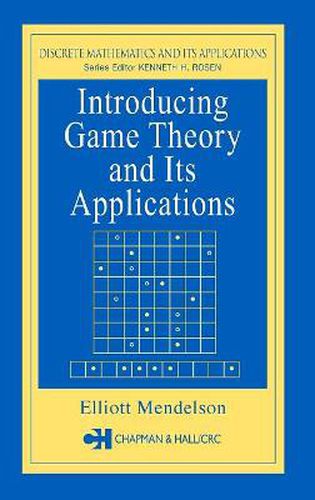Readings Newsletter
Become a Readings Member to make your shopping experience even easier.
Sign in or sign up for free!
You’re not far away from qualifying for FREE standard shipping within Australia
You’ve qualified for FREE standard shipping within Australia
The cart is loading…






The mathematical study of games is an intriguing endeavor with implications and applications that reach far beyond tic-tac-toe, chess, and poker to economics, business, and even biology and politics. Most texts on the subject, however, are written at the graduate level for those with strong mathematics, economics, or business backgrounds.
In a clear and refreshing departure from this trend, Introducing Game Theory and its Applications presents an easy-to-read introduction to the basic ideas and techniques of game theory. After a brief introduction, the author begins with a chapter devoted to combinatorial games–a topic neglected or treated minimally in most other texts. The focus then shifts to two-person zero-sum games and their solution. Here the author presents the simplex method, based on linear programming, for solving these games and develops within his presentation the required background in linear programming. The final chapter presents some of the fundamental ideas and tools of non-zero-sum games and games with more than two players, including an introduction to cooperative game theory.
This book will not only satisfy the curiosity of those whose interest in the subject was piqued by the 1994 Nobel Prize awarded to Harsanyi, Nash, and Selten. It also prepares its readers for more advanced study of game theory’s applications in economics, business, and the physical, biological, and social sciences.
$9.00 standard shipping within Australia
FREE standard shipping within Australia for orders over $100.00
Express & International shipping calculated at checkout
The mathematical study of games is an intriguing endeavor with implications and applications that reach far beyond tic-tac-toe, chess, and poker to economics, business, and even biology and politics. Most texts on the subject, however, are written at the graduate level for those with strong mathematics, economics, or business backgrounds.
In a clear and refreshing departure from this trend, Introducing Game Theory and its Applications presents an easy-to-read introduction to the basic ideas and techniques of game theory. After a brief introduction, the author begins with a chapter devoted to combinatorial games–a topic neglected or treated minimally in most other texts. The focus then shifts to two-person zero-sum games and their solution. Here the author presents the simplex method, based on linear programming, for solving these games and develops within his presentation the required background in linear programming. The final chapter presents some of the fundamental ideas and tools of non-zero-sum games and games with more than two players, including an introduction to cooperative game theory.
This book will not only satisfy the curiosity of those whose interest in the subject was piqued by the 1994 Nobel Prize awarded to Harsanyi, Nash, and Selten. It also prepares its readers for more advanced study of game theory’s applications in economics, business, and the physical, biological, and social sciences.